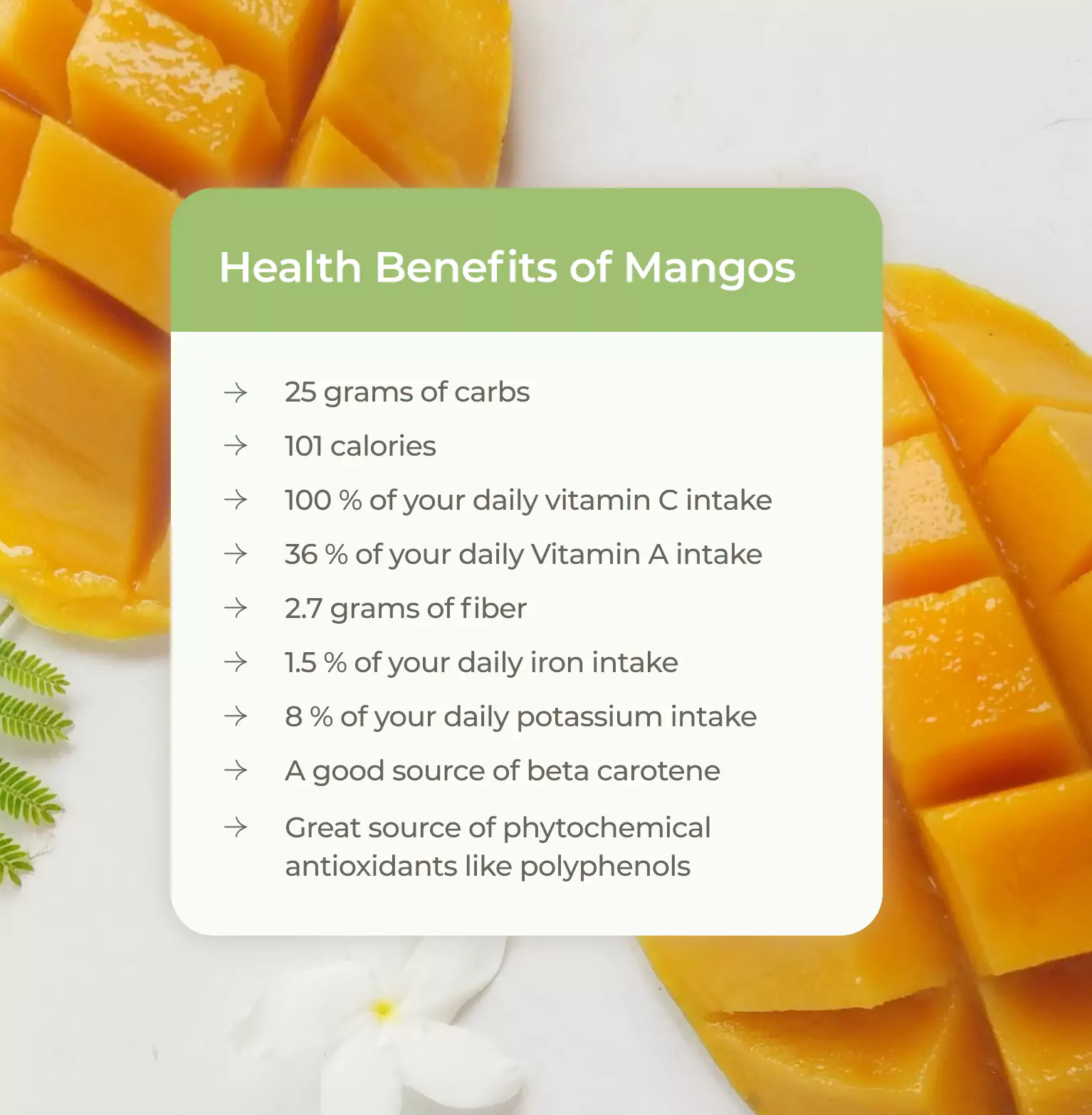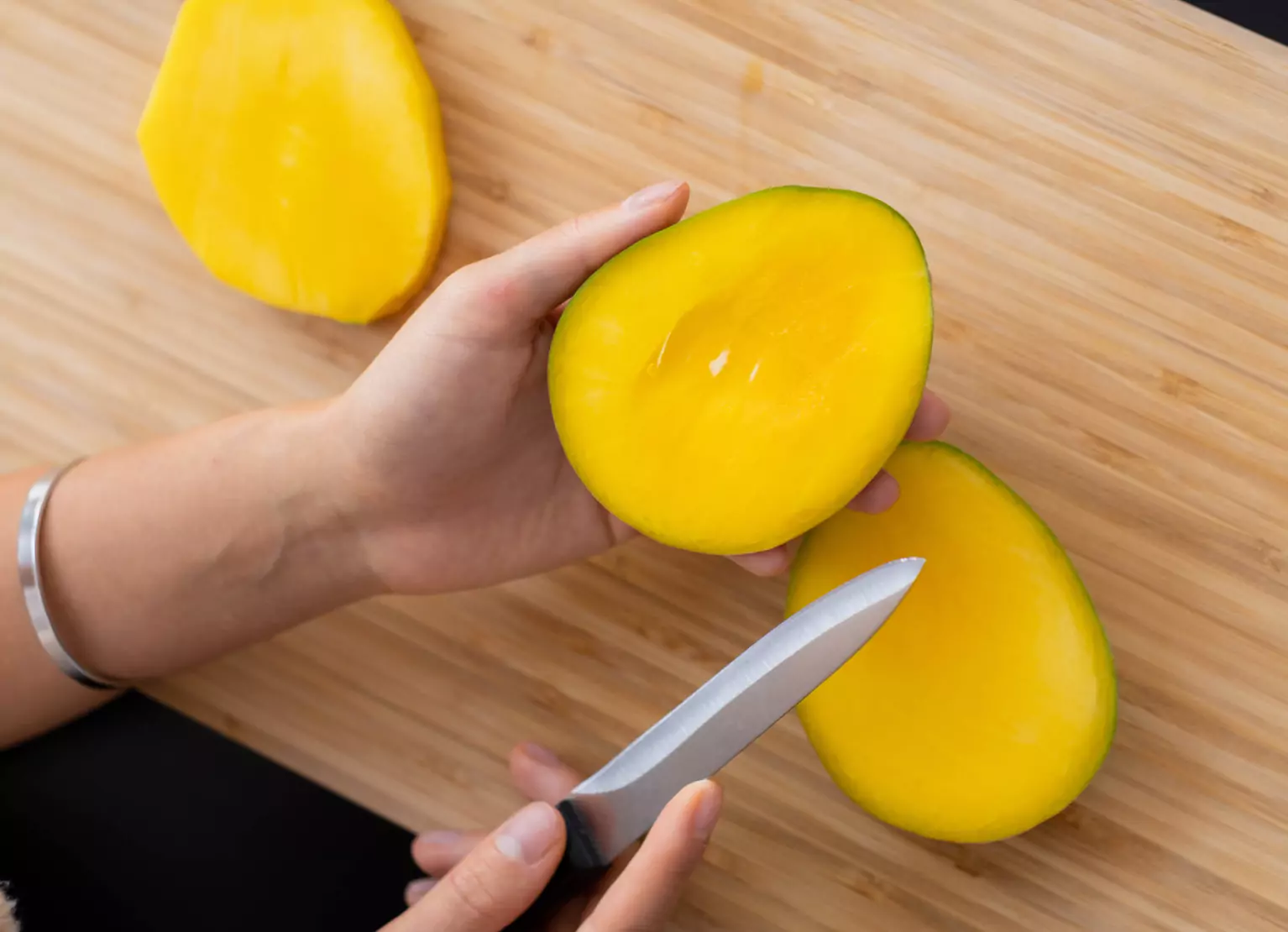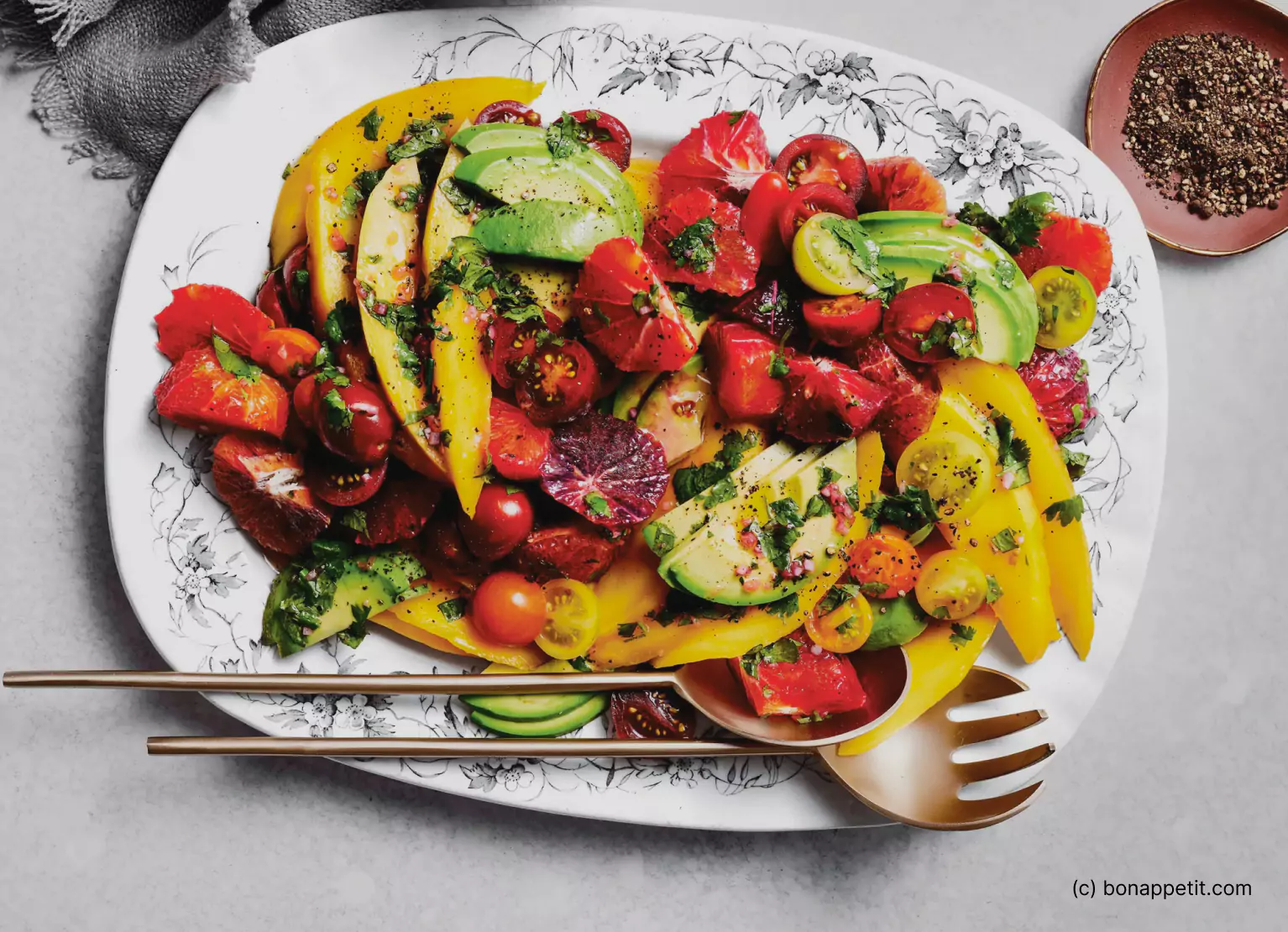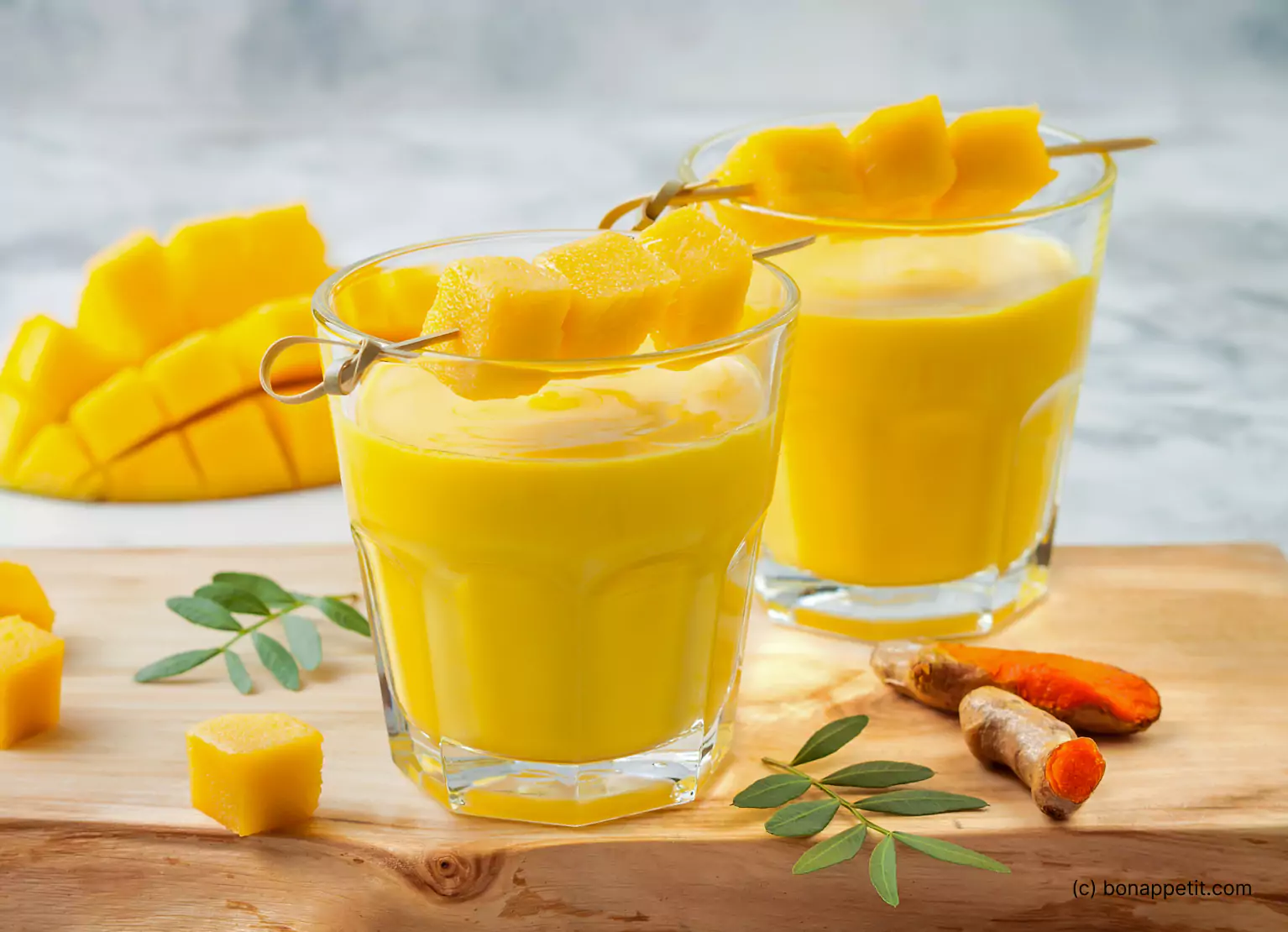Mango Glycemic Index: Understanding the Impact on Blood Sugar

Key Takeways
Mangos are a tropical fruit that have been grown and cultivated in different regions in Southeast Asia (and other parts of the world) for many centuries.
Mangos are a delicious, healthy treat to enjoy this time of year. After all, spring and summertime is peak mango season! But what health benefits do mangos provide? And is this fruit safe to eat without drastically impacting blood sugar?
If you love mangos and want to know the best way to incorporate them into your diet this summer, we’ll take you through all the different varieties as well as the health benefits mango can provide.
Why It’s Important to Include Fruit in Your Diet

According to the most recent Dietary Guidelines for Americans, the average American adult should be consuming 1.5 to 2.5 cups of fruits a day to get their recommended serving of vitamins and minerals.
These guidelines also advise that more than half of this serving size should come from whole fruits, as opposed to juices or other fruit sources.
Here’s what the research says about the health benefits of fruit consumption:
- Fruits and vegetables may help reduce risk of chronic diseases (such as heart disease and stroke).
- They help with body weight management and modest weight loss.
- Reduced mortality risk.
- Many fruits are great sources of vitamins, minerals, and fiber.
It’s clear that whole fruits are nutrient dense and can provide a variety of health benefits. However, about 80 percent of the U.S. population does not meet the dietary guideline.
Nutrients in Mangos
One serving size of mango (about half of a large mango) includes nutrients such as:

Eating mangos can be a great way to boost your daily intake of vitamins A and C. Because this fruit packs a punch, we like to call it the king of fruits.
Types of Mangos

Different types of mangos are found in many different countries around the world. However, the world’s largest producer of mangos is India, which produced over 20.9 million metric tons of mangos in 2021.
Bangladesh, Mexico, Pakistan, and the Philippines are also big producers of this fruit, and there are also a variety of different African and Colombian mango. Even parts of the United States, like Florida, also have mango-like derivatives called cultivars.
Some Popular Mangos Across the World
- Alphonso mango - India
- Carabao mango - Philippines
- Sindhri mango - Pakistan
- Ataulfo mango - Mexico
- Haden mango - Florida (USA)
- Julie mango - Jamaica
- Ivory mango - Thailand
- Tommy Atkins mango - Florida (USA)
- Hilacha mango - Colombia
Sugar Content of Different Mangos
With so many different varieties, you may be wondering whether they’re all the same or different when it comes to the amounts of sugar and other nutrients they contain.
Let’s break down the natural sugar content of different mangos:
- Tommy Atkins, Haden, Kent, and Keitt mango contain about 13.6 grams of sugar per 100 grams.
- Columbian mangos have 13.7 grams of sugar.
- African varieties like Sudanese mangos may contain anywhere from 10.5 to 32.4 percent sugar.
- A 100 gram serving of Ataulfo mangos contains 14 grams of sugar.
The sugar in mangos is usually found in the form of sucrose (made up of glucose and fructose), then fructose, then glucose.
Mangos and Blood Glucose

Similarly to grapes, mangos have a moderate amount of sugar, however, they still have a low glycemic index, or low GI, of 51. So how does this affect your blood glucose?
When foods have a low GI content, you likely won’t see as sharp of a blood sugar spike as you might after consuming a high GI food. However, because of the significant sugar content in mangos, eating this fruit by itself may still affect blood sugar levels. Keep in mind that just as with other types of fruit, the exact glucose effect may depend on your body and lifestyle.
Whether you have insulin resistance, are predisposed to type 2 diabetes, or even if you’re someone who is otherwise healthy, eating mangos without another source of fiber or protein can lead to a poor blood glucose response.
You may also notice a poor glycemic response if you eat a large portion size of mangos or eat a mango without any form of exercise afterwards, as these elements can affect what your glucose response looks like.
Tips for Balancing Your Blood Sugar
Here are some tips to maintain healthy blood sugar levels if you plan on snacking on this delicious fruit all summer long:
- Go for a walk after enjoying this fruit as a snack.
- Try pairing it with fiber and healthy fats for a better glucose response.
- If you pair this with a protein source, eat the protein source first. This can help encourage healthy blood glucose levels.
- Work with your nutritionist to create a meal plan that includes mango but is also tailored to your body’s needs and health goals.
- Watch out for proper portion sizes and find one that works best for your body. This may be to have one or two serving(s) of mango a week split up into several meals or days for lowered sugar content.
Three Tasty Mango Recipes to Try
So, if you want to reap some of the health benefits of mangos while they’re in season this summer, here are three delicious recipes you can add to your weekly routine.
- Mango and Avocado Salad by Bon Appetit

This top rated recipe throws a fresh twist to your idea of a traditional salad by using fruits like mango and avocados as the base. Both tasty and refreshing, this summer dish is a great lunch option to have under the sun.
You’ll need:
- ⅓ cup extra-virgin olive oil
- ⅓ cup fresh blood orange juice
- ¼ cup fresh lime juice
- 1 tablespoon honey
- 1 tablespoon kosher salt
- ½ teaspoon freshly ground black pepper
- 1 shallot, finely chopped
- 2 tablespoons finely chopped cilantro
- 4 blood oranges, peeled and sliced into irregular pieces
- 2 mangos, peeled, sliced
- 2 avocados, peeled, sliced
- 1 cup halved cherry tomatoes
Why We Love It
This recipe is refreshing and full of good fats from the olive oil and avocado. These ingredients can help balance your blood sugar response, and also may prevent spikes that may arise from the fruits and honey. Throw in a few nuts or some feta cheese for a little boost of extra protein and fat to make it a balanced meal!
2) Paleo Mango Pudding with Coconut Milk By What Great Grandma Ate

You can still enjoy a tasty mango in different ways even if you have food restrictions, thanks to this coconut milk pudding recipe! A perfect end to a healthy dinner, if you ask us.
You'll need:
- Mango chunks (or cut up mango)
- Gelatin
- Full-fat coconut milk
- Coconut sugar
- Handful of pecans (optional)
Why We Love It
Eating whole fruit for dessert is a great way to add some extra vitamins and minerals to your diet and can be delicious too! Mixing in a handful of nuts to this mixture can help you make sure that this combination of fats and carbohydrates won’t lead to an energy crash or a glucose spike.
3) Sweet and Salty Mango Lassi by Bon Appetit

This recipe is a real treat for those of you who are Indian mango lovers! Lassi is a traditional Indian drink that is a blend of yogurt, water, fruit, and spices. It’s easy to prepare and really hits the spot on a warm day!
You’ll need:
- 2 tablespoons cumin seeds
- ½ cup fresh lime juice
- 2 teaspoons black salt or kosher salt
- 4 cups plain whole-milk yogurt
- 1 can of unsweetened mango pulp
- Mint sprigs (for serving)
Why We Love It
This tasty drink is another great source of vitamins, minerals, and fats that you can sip on on a hot, summer day. Pair this drink with a meal full of protein and fiber (such as a salad with lean chicken breast) to support balanced glucose levels. If enjoying this drink as an afternoon snack, try eating a handful of nuts before sipping on this mango treat for optimal glucose levels!
Find the right Nutrisense programto turn insight into progress.
Go Beyond Glucose Data with Nutrisense
Your glucose can significantly impact how your body feels and functions. That’s why stable levels are an important factor in supporting overall wellbeing. But viewing glucose isn't enough. Nutrisense, you’ll be able to learn how to use your body's data to make informed lifestyle choices that support healthy living.
One-to-one coaching
Sign up to access insurance-covered video calls to work with a glucose expert: a personal registered dietitian or certified nutritionist who will help tailor your lifestyle and diet to your goals.
Monitor and measure what matters
With the Nutrisense CGM Program, you can monitor your glucose with health tech like glucose biosensors and continuous glucose monitor (CGM)s, and analyze the trends over time with the Nutrisense App. This will help you make the most informed choices about the foods you consume and their impact on your health.
Find your best fit
Ready to take the first step? Start with our quiz to find the right Nutrisense program to help you take control.

Amanda is a Nutrition Manager and Registered Dietitian, with a Masters in Dietetics from Stephen F. Austin State University. Originally from south GA, she got her undergrad degree from Texas Tech University. She worked at a hospital in Fort Worth, TX, for 4 years as a dietitian, counseling those living with HIV.




